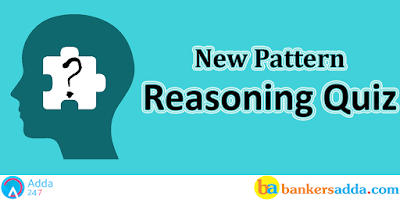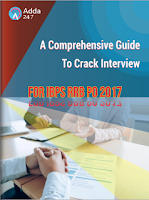Dear Readers,
The reasoning is a game of wits and presence of mind! Yes, it is true and it might seem as the greatest of the challenge after English Section’s surprises but yet this one can easily be dealt with. You just need correct practice and hardwire your brain to quickly make decisions about what to attempt and what to leave. And for same we are providing you questions of Reasoning Question and Answers. Solve these to Practice latest pattern reasoning question for bank exams.
Directions (1-5): Study the following information carefully and answer the given questions.
A, B, C, D, E, F, G and H are sitting around a square table in such a way that four of them sit at four corners of the square table while other four sit in the middle of each of the four sides. The one who sits at the four corners face the centre of the table while those who sit in the middle of the sides face outside. Each of them likes a different magazine viz. Frontline, Outlook, Femina, Verve, Autocar, Filmfare, Tinkle and Grazia but not necessarily in the same order.
C sits third to the left of the one who likes Grazia . The one who likes Grazia faces outside. Only two persons sit between C and H. The one who likes Frontline sits on the immediate right of H. The one who likes Autocar sits second to the right of G. G is neither an immediate neighbour of H nor of C. G does not like Grazia . Only one person sits between A and the one who likes Autocar . D sits on the immediate left of the one who likes Filmfare. G does not like Filmfare . E likes Tinkle . E is not an immediate neighbour of A. The one who likes Outlook is an immediate neighbour of E. The one who likes Verve is an immediate neighbour of F.
C sits third to the left of the one who likes Grazia . The one who likes Grazia faces outside. Only two persons sit between C and H. The one who likes Frontline sits on the immediate right of H. The one who likes Autocar sits second to the right of G. G is neither an immediate neighbour of H nor of C. G does not like Grazia . Only one person sits between A and the one who likes Autocar . D sits on the immediate left of the one who likes Filmfare. G does not like Filmfare . E likes Tinkle . E is not an immediate neighbour of A. The one who likes Outlook is an immediate neighbour of E. The one who likes Verve is an immediate neighbour of F.
Q1. What is the position of the one who likes Filmfare with respect to G?
(a) Second to the left
(b) Third to the right
(c) Fourth to the left
(d) Second to the right
(e) Third to the left
Q2. Who among the following represent the immediate neighbours of the one who likes Autocar?
(a) B, F
(b) C, E
(c) B, E
(d) D, F
(e) F, H
Q3. Who among the following sits exactly between H and B?
(a) C
(b) The one who likes Autocar
(c) The one who likes Femina
(d) E
(e) A
Q4. Which of the following is true regarding B?
(a) B is one of the immediate neighbours of D.
(b) The one who likes Grazia is an immediate neighbour of B.
(c) B sits second to the left of H.
(d) B likes Tinkle .
(e) B is an immediate neighbour of the one who likes Frontline .
Q5. Who amongst the following sits diagonally opposite the one who likes Frontline ?
(a)The one who likes Outlook
(b)D
(c) B
(d) The one who likes Femina
(e) The one who likes Verve
Directions (6-10) In the following questions, the symbols @, $, %, # and © are used with the following meanings illustrated—
(i) ‘X @ Y’ means ‘X is not smaller than Y’.
(ii) ‘X $ Y’ means ‘X is not greater than Y’.
(iii) ‘X % Y’ means ‘X is neither smaller than nor equal to Y’.
(iv) ‘X # Y’ means ‘X is neither greater than nor equal to Y’.
(v) ‘X © Y’ means ‘X is neither smaller than nor greater than Y’.
In each of the following questions assuming the given statements to be true, find out which of the two conclusions I and II given below them is/are definitely true. Give answer—
(a)If only I is true.
(b)If only II is true.
(c)If either I or II is true
(d)If neither I nor II is true.
(e)If both I and II are true.
Q6.Statements: P $ T, T @ L, U % L
Conclusions: I. P @ L II. U©L
Q7.Statements: A @B, B%D, D©K
Conclusions: I. A©K II. B%K
Q8.Statements: J # K, K©L, P$L
Conclusions: I. P$K II. J#L
Q9.Statements: T % O, T # M, M@ V
Conclusions: I. M % T II. O % V
Q10.Statements: K @ T, T # C, C $ P
Conclusions: I. C © K II. C % K
Directions (11-15)): Study the following arrangement carefully and answer the questions given below.
5 U 7 W * B @ D F © 1 Z 6 HY J % 4 T E K I 9 # P A $ Q 3 8 N
Q11. How many such symbols are there in the above arrangement, each of which is immediately preceded by a number and but not immediately followed by a vowel?
(a) None
(b) One
(c) Two
(d) Three
(e) More than three
Q12. How many such vowels are there in the above arrangement, each of which is immediately preceded by a number and also immediately followed by a number?
(a) None
(b) One
(c) Two
(d) Three
(e) More than three
Q13. If all the symbols and numbers are removed from the above arrangement, which of the following will be the 3rd to the right of the 3rd from the left end?
(a) B
(b)H
(c) D
(d) I
(e) Z
Q14. If all the numbers are removed from the above arrangement, which of the following element will be ninth from left end?
(a) J
(b) Z
(c) B
(d) *
(e) H
Q15. Four of the following five are alike in a certain way based on their positions in the above arrangement and so from a group. Which of the one that does not belong to that group?
(a)5N
(b) U8
(c) 73
(d) *P
(e) WQ
You May also like to Read:




 Reasoning Quiz For Bank Foundation 2024 ...
Reasoning Quiz For Bank Foundation 2024 ...
 Reasoning Quiz For Bank Foundation 2024 ...
Reasoning Quiz For Bank Foundation 2024 ...



